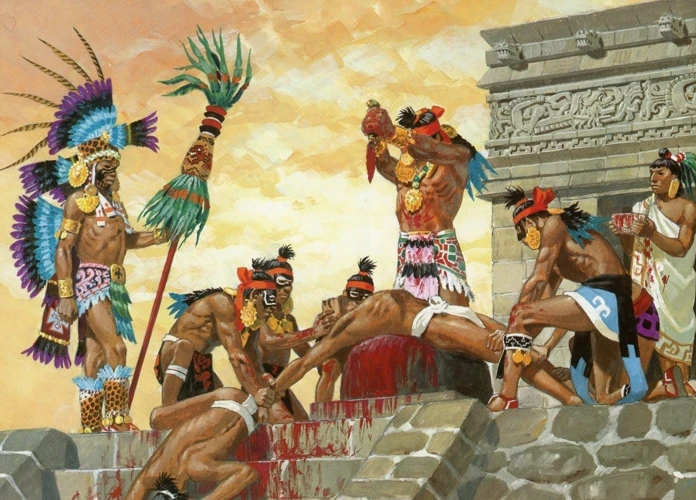The ancient Aztec civilization continues to captivate our imaginations with its rich culture and intriguing religious practices. One aspect that stands out prominently is their rituals and sacrifices, which were carried out with great fervor and dedication. The purpose and significance behind these rituals is a topic of much debate and interest. In this article, we delve into the world of Aztec rituals and sacrifices, seeking to understand their connection with the gods, the role they played in ensuring cosmic balance, and the different types of rituals that were performed. Additionally, we explore the significance of these sacrifices, both in terms of religious symbolism and social and political power. Finally, we examine the controversy and modern understanding surrounding these practices. Prepare to be astounded and enlightened as we unravel the mysteries of Aztec rituals and sacrifices.
Contents
- Ancient Aztec Civilization
- The Purpose of Aztec Rituals
- Types of Aztec Rituals
- Significance of Aztec Sacrifices
- Controversy and Debate
- Conclusion
-
Frequently Asked Questions
- 1. What were the religious beliefs of the Aztecs?
- 2. Why did the Aztecs perform rituals and sacrifices?
- 3. What types of rituals did the Aztecs engage in?
- 4. How did bloodletting play a role in Aztec rituals?
- 5. What was the significance of human sacrifices in Aztec culture?
- 6. Did Aztec rituals have religious symbolism?
- 7. How did rituals and sacrifices enhance social and political power in Aztec society?
- 8. How do different cultural perspectives view Aztec rituals and sacrifices?
- 9. How do modern interpretations of Aztec rituals differ from historical understandings?
- 10. Can we fully comprehend the purpose and significance of Aztec rituals and sacrifices?
- References
-
Frequently Asked Questions
- What were the main religious beliefs of the Aztecs?
- Why did the Aztecs perform rituals and sacrifices?
- What was the purpose of bloodletting in Aztec rituals?
- How did human sacrifices play a role in Aztec rituals?
- What were ritualistic celebrations in Aztec culture?
- What was the religious symbolism behind Aztec sacrifices?
- How did Aztec sacrifices contribute to social and political power?
- How controversial are Aztec rituals and sacrifices today?
- What do cultural perspectives say about Aztec rituals and sacrifices?
- What is the modern understanding of Aztec rituals and sacrifices?
- References
- Read More
Ancient Aztec Civilization
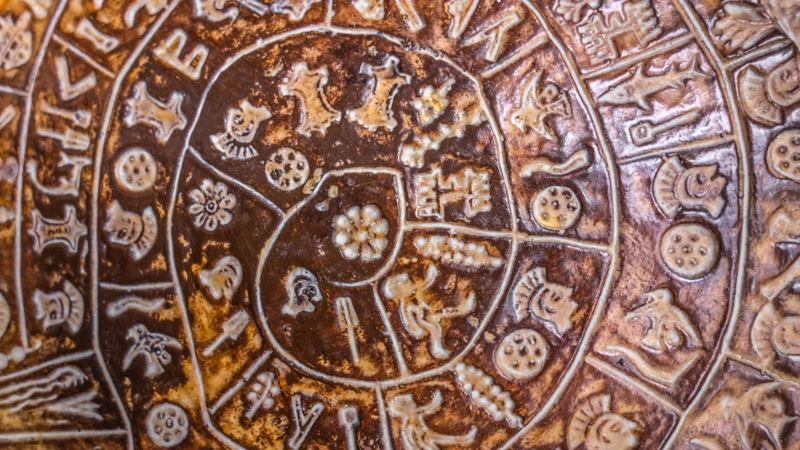
The Ancient Aztec Civilization stands as a testament to the power and grandeur of Mesoamerican cultures. With their capital city of Tenochtitlan as the thriving center, the Aztecs flourished from the 14th to the 16th century. A remarkable blend of art, architecture, and innovation, they established a society deeply rooted in both culture and religion. The Aztecs revered their gods, such as Huitzilopochtli and Quetzalcoatl, and believed in the importance of fulfilling their divine duties. Rituals and sacrifices played a central role in their religious practices, serving as a means to establish a connection with the celestial beings. The Aztec calendar, influenced by the origins and meanings of the Orion constellation, structured their rituals and events. Societal roles were clearly defined, with warriors being highly regarded and the priesthood holding great power. The Aztec civilization remains a fascinating chapter in history, offering a glimpse into a world where religion and societal hierarchies shaped their way of life.
1.1 Aztec Culture and Religion
Aztec culture and religion were deeply intertwined, with religious beliefs permeating every aspect of daily life for the Aztec people. At the core of their religious practices was the worship of a pantheon of gods and goddesses, each representing different aspects of the natural world and human existence. The Aztecs believed that their gods required sustenance and human devotion in order to maintain balance and order in the universe. This belief system shaped their worldview and gave rise to a complex ritualistic culture. The role of religion extended beyond the spiritual realm and influenced social and political structures. The priesthood held significant power and influence, serving as intermediaries between the mortal world and the divine. Temple complexes were central to Aztec religious practices, serving as sacred spaces for ceremonies, sacrifices, and offerings to the gods. These rituals were not limited to religious leaders but were also integral to the lives of ordinary Aztec individuals. The rituals and ceremonies were characterized by vibrant costumes, elaborate music and dance, and intricate symbolic representations. They played a critical role in connecting the mortal realm with the divine. Aztec culture and religion were inseparable, shaping every aspect of life for the Aztec people and providing them with a sense of identity, purpose, and collective belonging.
1.2 Rituals and Sacrifices
Rituals and sacrifices were at the heart of Aztec religious practices, embodying the deep spiritual connection between the mortal realm and the divine. The Aztecs believed that these rituals played a vital role in maintaining harmony in the universe and ensuring the favor of the gods. Their rituals encompassed a wide range of practices, from bloodletting ceremonies to grand-scale human sacrifices. Bloodletting was a common form of ritual, where individuals would pierce their own skin, often on specific body parts, to offer their blood as a sacrifice to the gods. This act was seen as a way to nourish and sustain the deities, thereby maintaining their aid and protection for the Aztec people. Human sacrifices, on the other hand, were reserved for significant occasions, such as the dedication of temples or during important festivals. The sacrificial victims were often prisoners of war or individuals specifically chosen for their physical perfection, representing the ultimate offering to the gods. These sacrifices were believed to strengthen the bond between the mortal and divine realms, securing prosperity and protection for the Aztec civilization. Ritualistic celebrations were also an integral part of Aztec culture. These included elaborate processions, dances, and performances, showcasing the artistic and cultural prowess of the Aztecs. These celebrations served as opportunities to honor the deities, express gratitude, and seek their continued blessings. The rituals and sacrifices of the Aztec civilization were deeply steeped in religious symbolism and belief, shaping the way of life for its people and cementing their spiritual connection with the divine. To learn more about the role of heroes in ancient civilizations, you can read about ancient Greek heroes who played significant roles in mythology. Additionally, understanding the role of women in Maya society offers valuable insights into the diverse cultural practices of Mesoamerican civilizations.
The Purpose of Aztec Rituals
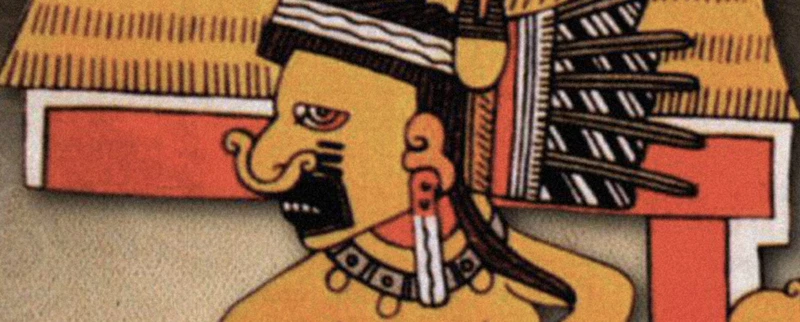
The purpose of Aztec rituals was deeply rooted in their belief system and their desire to maintain a harmonious relationship with the gods. These rituals served as a means of connecting with the celestial beings and ensuring cosmic balance. The Aztecs believed that their actions directly impacted the natural world and that performing rituals would appease the gods and prevent disasters or misfortunes. Through these rituals, they sought to honor and communicate with the gods, seeking their protection, guidance, and blessings. Additionally, the Aztecs believed that their rituals played a crucial role in maintaining the cyclical nature of the universe. By engaging in these sacred practices, they believed they were upholding the cosmic order and safeguarding the continuation of life. The purpose of Aztec rituals went beyond mere religious observance; it was an integral part of their worldview, connecting the spiritual and physical realms to ensure the well-being of their civilization.
2.1 Connection with the Gods
The Aztecs believed in a deep and sacred connection with their gods. Through rituals, they sought to establish a direct line of communication and maintain a harmonious relationship with the celestial beings. These rituals were performed by the priests, who acted as intermediaries between the human realm and the divine realm. The priests would meticulously follow the prescribed ceremonies and offer various offerings to appease the gods. These offerings often included valuable items like precious stones, feathers, and even extravagant human sacrifices.
The Aztecs believed that their actions directly influenced the wellbeing of their gods, and by extension, the world around them. They viewed their rituals as a means of sustaining the cosmic balance, ensuring the sun rose, the rains fell, and the crops thrived. The connection with the gods was considered essential for the continued prosperity and survival of their civilization.
To maintain this connection, the Aztecs developed a complex system of ceremonies and festivals throughout the year. Each god had specific rituals associated with them, and the priests meticulously followed these rituals to please and honor the respective deity. These rituals ranged from bloodletting ceremonies to offerings of food, flowers, and incense.
The Aztec rituals were not solely performed in the temples or ceremonial centers. They also took place in homes, where people would create altars and offer prayers, flowers, and food to their household gods. This personal connection was an integral part of everyday life and reinforced the belief in the interplay between humans and the divine.
The connection with the gods was a foundational element of Aztec culture and religion. It shaped every aspect of their lives, from their social structure to their agricultural practices. Through intricate rituals and offerings, they sought to maintain a harmonious relationship with their gods, ensuring their continued protection and favor. This connection with the divine realm provided the Aztecs with a sense of purpose, unity, and guidance in their daily lives.
2.2 Ensuring Cosmic Balance
Ensuring cosmic balance was a fundamental belief in Aztec culture and a critical aspect of their rituals. The Aztecs believed that the universe relied on a delicate equilibrium between various forces, and any disruption to this equilibrium could result in cataclysmic events or the wrath of the gods. Through their rituals, the Aztecs aimed to maintain this cosmic balance. They believed that by offering sacrifices and performing specific ceremonies, they could appease the gods and prevent any imbalance. This notion extended to all aspects of life, from agricultural fertility to societal harmony. The Aztecs understood that their world was interconnected, and by maintaining cosmic balance, they believed they could ensure the prosperity and well-being of their people. The rituals conducted in this pursuit were often elaborate and meticulously planned, emphasizing the importance the Aztecs placed on upholding cosmic order. By fulfilling their religious obligations, they believed they were contributing to the overall stability of the universe. Through their dedication to ensuring cosmic balance, the Aztecs sought to navigate their way through a complex and sometimes unpredictable world, seeking harmony and equilibrium in all aspects of life.
Types of Aztec Rituals
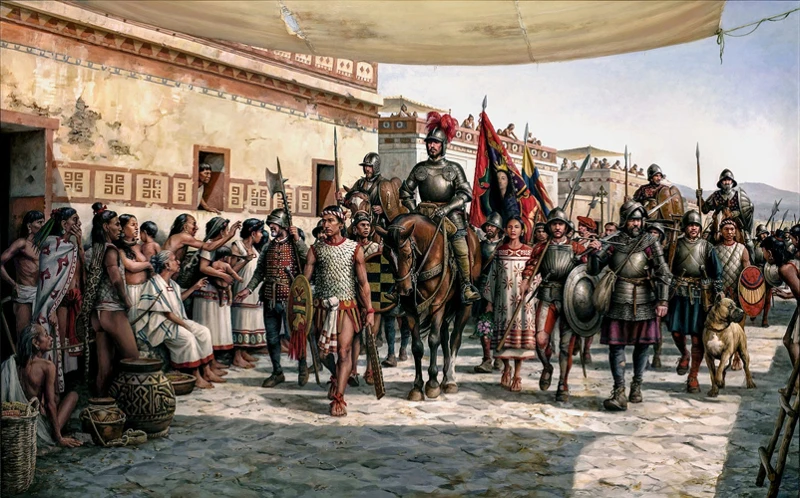
The Aztec civilization was characterized by a variety of rituals, each serving a distinct purpose and carrying its own significance. These rituals played an integral role in the Aztec religious practices and were performed with utmost devotion. One prominent type of ritual was bloodletting, a practice in which individuals would pierce their skin or limbs to offer their blood as a sacrifice to the gods. Another notable form of ritual was human sacrifices, considered the most sacred and powerful act of worship. These sacrifices involved capturing prisoners from neighboring tribes or even members of their own community, who would then be offered to the gods as a way to ensure prosperity and cosmic balance. Lastly, the Aztecs also engaged in ritualistic celebrations, which included feasts, dances, and music to honor their gods and commemorate significant events. These types of rituals reflected the deeply ingrained religious beliefs and cultural traditions of the Aztec civilization.
3.1 Bloodletting
Bloodletting was a significant and intricate ritual in the Aztec civilization. It was believed that by extracting and offering blood, the Aztecs could appease the gods and ensure their favor. This ritualistic practice involved various methods and was performed by both priests and individuals seeking divine intervention.
One method of bloodletting involved piercing different parts of the body, such as the tongue, earlobes, or limbs, with obsidian blades or spines of maguey plants. The blood would then be collected and presented as an offering to the gods. This act was considered a deeply personal and sacred form of communication with the celestial beings.
Another form of bloodletting was self-sacrifice, where individuals would inflict wounds upon themselves, typically on the earlobes or tongue, to release blood. These acts of self-sacrifice were done as a display of devotion and loyalty to the gods. Warriors were known to partake in this ritual before going into battle, believing that the shedding of their blood would grant them strength and protection.
Bloodletting ceremonies were also incorporated into larger ritualistic events, such as the New Fire ceremony, where a new fire was kindled to mark the beginning of a new cycle. The act of shedding blood during these events was seen as a means of renewing the life force and ensuring the continued balance of the cosmos.
The significance of bloodletting went beyond religious devotion. It was believed to have healing properties, with blood perceived as a powerful life force. Aztec healers or “tlapazani” would use bloodletting as a form of therapeutic treatment, aiming to restore the equilibrium of the body and spirit.
Bloodletting was an integral part of Aztec culture, deeply ingrained in their religious practices and everyday life. Its purpose ranged from divine communication and seeking protection to maintaining cosmic balance and healing. This ritual serves as a testament to the complexity and spirituality of the Aztec civilization.
3.2 Human Sacrifices
Human sacrifices were an integral part of Aztec rituals, considered the most profound and sacred form of offering to the gods. These sacrifices were performed to appease the deities, ensuring their continued blessings and maintaining cosmic balance. The ritualistic practice involved the selection of captives or volunteers, who were often prisoners of war or individuals from lower social classes. These individuals were esteemed for their bravery, as they willingly offered themselves for sacrifice, believing it to be an honor. The process of sacrifice varied, but it typically involved the removal of the heart while the victim was still alive. The heart was then offered to the gods as a symbol of devotion and gratitude. The act of human sacrifice was deeply religious, viewed as a necessary sacrifice for the preservation and prosperity of their civilization. It was believed that the sun god, Huitzilopochtli, required the nourishment of human hearts to rise each day. The scale of these sacrifices was immense, with records indicating that hundreds, and sometimes even thousands, of individuals were sacrificed during important ceremonial events. The bodies of the sacrificed were often ritually dismembered, and certain body parts were used for ceremonial purposes or consumed as part of religious rituals. The symbolism behind human sacrifices in Aztec culture reflected their deep-rooted beliefs in the cyclical nature of life, death, and rebirth. These sacrifices were not only offerings to the gods but also served as a means to sustain the cosmic order, ensuring the well-being and prosperity of their civilization. The practice of human sacrifices by the Aztecs continues to provoke judgment and controversy in modern times, as it clashes with contemporary moral and ethical standards.
3.3 Ritualistic Celebrations
Ritualistic celebrations were an integral part of the Aztec civilization, reflecting their deep religious beliefs and cultural practices. These celebrations were marked by vibrant ceremonies and events that showcased the unique customs and traditions of the Aztec people. One such celebration was the famous “Toxcatl” festival, which honored the god Tezcatlipoca. This grand event lasted for an entire month and included theatrical performances, processions, and elaborate rituals. Another notable celebration was the “Panquetzaliztli” festival, dedicated to the god Huitzilopochtli. During this event, the Aztecs participated in various activities such as dancing, singing, and feasting. The “Tlacaxipehualiztli” festival, which paid homage to the god Xipe Totec, involved gladiatorial combat, where captured warriors fought for their lives. These ritualistic celebrations allowed the Aztec people to express their devotion and gratitude to the gods while reinforcing social bonds within the community. Through these festivities, the Aztecs celebrated their rich cultural heritage and reaffirmed their place in the intricate tapestry of the ancient Mesoamerican world.
Significance of Aztec Sacrifices
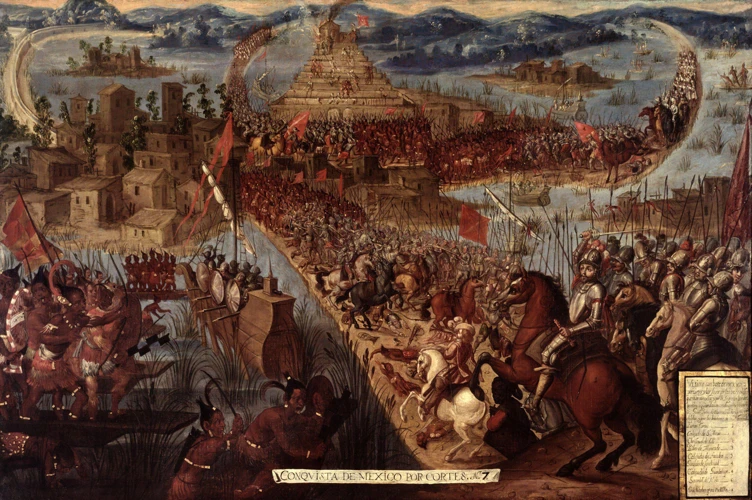
The significance of Aztec sacrifices cannot be overstated, as they held both religious and socio-political importance in the Aztec society. One of the main reasons for these sacrifices was religious symbolism. The Aztecs believed that their gods required sustenance in the form of human blood and hearts to ensure the continued existence of the universe. Through these sacrifices, they sought to maintain a harmonious relationship with the gods and ensure the well-being of their civilization. Additionally, these rituals played a crucial role in the consolidation of social and political power. The act of sacrificing individuals, particularly captured warriors from rival tribes, served as a display of dominance and intimidation. It asserted the authority and prowess of the Aztec empire, reinforcing their position as the dominant force in Mesoamerica. The sacrifices also had the function of social cohesion, instilling fear and solidarity among the Aztec people. They were collective acts that brought the community together, reinforcing their shared identity and values. The significance of Aztec sacrifices extends beyond mere religious practices, encompassing deep cultural, social, and political dimensions.
4.1 Religious Symbolism
Religious symbolism played a pivotal role in Aztec rituals and sacrifices, reflecting the deep spiritual connection between the mortal realm and the divine world. Through these rituals, the Aztecs sought to communicate with their gods and ensure their favor and protection. Various elements and symbols held special significance in these religious practices.
1. Blood: Blood was regarded as a sacred substance, believed to contain the vital life force or “tonalli.” It was seen as a precious offering to the gods, symbolizing the renewal of life and energy. The Aztecs practiced bloodletting, where individuals would pierce their own bodies, typically the tongue or ears, to offer their blood. The blood would be collected and used in various rituals as an offering to the gods.
2. Gods and Goddesses: The Aztecs had an extensive pantheon of gods and goddesses, each representing different aspects of nature, fertility, war, and life. These deities were often depicted in religious iconography and statues, adorned with intricate details and symbols. Symbolic items associated with specific gods, such as feathers for Quetzalcoatl or skulls for Mictlantecuhtli, were used in rituals to honor and invoke their presence.
3. Calendar: The Aztecs had a complex and highly accurate calendar system, which played a crucial role in their religious symbolism. Each day and month held specific meanings and associations with deities and events. Rituals were performed at specific times according to the calendar, aligning with the cosmic cycles and ensuring harmony in the universe.
4. Offerings: The Aztecs made elaborate offerings to the gods, including food, flowers, and precious items. These offerings were meticulously prepared and arranged, symbolizing gratitude, abundance, and reciprocity. They believed that through these offerings, they could establish a sacred bond with the divine beings and receive blessings in return.
Religious symbolism permeated every aspect of Aztec rituals and sacrifices, imbuing them with a spiritual depth and meaning. It served as a medium of communication and reverence, fostering a sense of connection, and seeking the divine presence in their lives. The intricate understanding of these symbolic elements showcased the profound spiritual beliefs of the Aztec civilization.
In the Aztec civilization, sacrifices held significant social and political power. Those who were chosen as sacrificial victims, known as “ixiptla,” were considered sacred vessels through which the gods communicated with the mortal realm. The act of sacrificing someone, whether they were prisoners of war or volunteers, elevated the societal status of the ruling elite. It demonstrated their authority, strength, and ability to appease the gods. Public spectacles of sacrifice, such as the famous Templo Mayor in Tenochtitlan, showcased the might and splendor of Aztec rulers. By participating in these rituals, the ruling class asserted their dominance and solidified their grip on power.
Additionally, the political implications of sacrifices cannot be underestimated. The Aztec empire was a vast and diverse realm, comprising numerous city-states and territories. Through the ritual act of sacrifice, the ruling elite aimed to secure the loyalty and obedience of subject communities. The fear and awe inspired by public displays of ritualistic violence served as a powerful deterrent, keeping subjects in line and discouraging rebellion. Sacrifices were also used as a form of tribute or payment to gain the support of allies and vassals.
The distribution of sacrificial victims had political implications as well. The Aztec rulers strategically allocated victims to different regions and influential individuals, thereby forging alliances and maintaining control over their vast empire. By granting certain communities the privilege of hosting sacrificial ceremonies, the rulers ensured their loyalty and created a sense of indebtedness.
The social and political power of sacrifices in Aztec society cannot be overstated. The act of sacrificing individuals elevated the status of the ruling elite and solidified their authority. Sacrifices served as a means to instill fear, maintain control, and forge alliances within the empire. The rituals and ceremonies surrounding sacrifices were a crucial aspect of Aztec political and social life, shaping the civilization’s dynamics and hierarchy.
Controversy and Debate

Controversy and debate surround the rituals and sacrifices performed by the Aztecs. Critics argue that these acts of violence and bloodshed were barbaric and unnecessary, reflecting a brutal society. Some believe that the Spanish conquistadors exaggerated the extent and frequency of human sacrifices to justify their colonization efforts. Others contend that the Aztecs had a deeply ingrained belief system that compelled them to carry out these rituals. From a cultural perspective, it is essential to consider the Aztecs’ worldview and the role these practices played within their society. Modern understanding of Aztec rituals acknowledges the complexity of their religious beliefs and the cultural context in which these acts occurred. While there is ongoing debate, it is crucial to approach the topic with an open mind, acknowledging the differing cultural perspectives and the limitations inherent in interpreting historical events.
5.1 Cultural Perspectives
In exploring the cultural perspectives surrounding Aztec rituals and sacrifices, it is crucial to understand that these practices were deeply ingrained in the fabric of Aztec society. The Aztecs believed that the gods required nourishment in the form of blood and human life to sustain the cosmic order and ensure the continuity of the universe. From this cultural standpoint, rituals and sacrifices were seen as necessary and sacred acts to maintain the balance between the earthly realm and the divine. The notion of sacrificing humans, in particular, may seem shocking and barbaric from a modern perspective, but it was perceived as a sacred duty and an offering of utmost significance by the Aztecs. It is vital to approach this topic with a nuanced understanding of the cultural context, recognizing the deeply held beliefs and religious significance attributed to these rituals. By doing so, we can gain a better appreciation for the complexity of the Aztec worldview and the profound impact it had on their cultural practices.
5.2 Modern Understanding
Modern understanding of Aztec rituals and sacrifices has undergone significant shifts and revisions in recent years. With the advancement of archaeological research and the exploration of Aztec codices, scholars have gained deeper insights into the complexities and nuances of these practices. One key aspect of modern understanding is the recognition of the multifaceted nature of Aztec rituals. While they were undoubtedly religious in nature, they also had social and political dimensions. It is now acknowledged that human sacrifices were not carried out solely for appeasing the gods, but also to maintain social order and solidify political power. Additionally, there is a growing understanding of the Aztecs’ cosmological beliefs and the role of rituals in maintaining cosmic equilibrium. These insights challenge earlier views that labelled the Aztecs as barbaric or bloodthirsty. Today, the emphasis is on appreciating the cultural and historical context in which these rituals occurred and recognizing the complexities of religious practices. While debates and controversies persist, the modern understanding of Aztec rituals and sacrifices reflects a more nuanced and holistic perspective that seeks to shed light on the diverse motivations and significance behind these ancient practices.
Conclusion

– In conclusion, the ancient Aztec civilization leaves us with a complex and intriguing legacy. The rituals and sacrifices performed by the Aztecs were deeply intertwined with their religious beliefs and played a crucial role in their society. These practices were seen as a means to establish a connection with their gods and ensure cosmic balance.
– The purpose of Aztec rituals went beyond simple religious devotion. Bloodletting, human sacrifices, and ritualistic celebrations were all part of their religious ceremonies. These rituals served as a way to honor the gods, seek divine intervention, and appease cosmic forces.
– The significance of Aztec sacrifices extended beyond religious symbolism. It played a pivotal role in consolidating social and political power. The ability to carry out elaborate rituals and sacrifices bestowed prestige upon rulers and provided a means of asserting dominance over neighboring tribes.
– However, controversy and debate surround the practices of the Aztecs. From a cultural perspective, it is essential to understand these rituals within the context of their time and cultural beliefs. Outsiders may condemn these practices as barbaric, but it is crucial to approach the topic with historical empathy and cultural sensitivity.
– Modern understanding of Aztec rituals continues to evolve as new archaeological discoveries and research shed light on this ancient civilization. The study of Aztec rituals not only provides insight into their beliefs and practices but also enriches our broader understanding of human history and the diversity of cultural expressions.
Overall, examining the purpose, types, and significance of Aztec rituals and sacrifices allows us to appreciate the complexities of this ancient civilization. From their fervent religious beliefs to their intricate social and political dynamics, the Aztecs left a lasting impact that continues to fascinate and compel our exploration.
Frequently Asked Questions

1. What were the religious beliefs of the Aztecs?
The Aztecs had a complex religious belief system that included the worship of numerous gods and goddesses. They believed that their gods controlled various aspects of life, including agriculture, warfare, and fertility.
2. Why did the Aztecs perform rituals and sacrifices?
Rituals and sacrifices were essential to the Aztecs as they believed it was necessary to maintain a connection with the gods and ensure the cosmic balance. They believed that by offering blood and sacrifices, they could sustain the world’s cycle and prevent calamity.
3. What types of rituals did the Aztecs engage in?
The Aztecs participated in a range of rituals, including bloodletting ceremonies, human sacrifices, and ritualistic celebrations. These rituals varied in complexity and purpose, serving religious, cultural, and political functions.
4. How did bloodletting play a role in Aztec rituals?
Bloodletting was a significant part of Aztec rituals, where individuals would pierce their bodies to offer their blood to the gods. This act represented a form of personal sacrifice and was believed to strengthen the connection between humans and deities.
5. What was the significance of human sacrifices in Aztec culture?
Human sacrifices were seen as the ultimate offering to the gods, ensuring their favor and protection. The Aztecs believed that the gods required human blood to sustain themselves and maintain the order of the universe.
6. Did Aztec rituals have religious symbolism?
Aztec rituals were deeply symbolic, representing various aspects of their religious beliefs. Symbols and gestures were used to convey messages, honor the gods, and communicate with the spiritual realm.
Rituals and sacrifices held immense social and political significance in Aztec society. Participation in rituals allowed individuals to showcase their devotion to the gods and gain status within their communities. Additionally, rulers and priests utilized these ceremonies to solidify their authority and maintain control.
8. How do different cultural perspectives view Aztec rituals and sacrifices?
Views on Aztec rituals and sacrifices vary among different cultural perspectives. While some may perceive them as cruel and barbaric, others interpret them as an integral part of Aztec religious and cultural heritage, highlighting the complexity of understanding historical practices within their specific context.
9. How do modern interpretations of Aztec rituals differ from historical understandings?
Modern interpretations of Aztec rituals have evolved over time. Historians and scholars now strive to view these practices through a more nuanced lens, considering cultural, religious, and political factors. Additionally, contemporary perspectives also emphasize the agency and motivations of Aztec individuals involved in these rituals.
10. Can we fully comprehend the purpose and significance of Aztec rituals and sacrifices?
While we can study and analyze the available historical evidence, the full understanding of the purpose and significance of Aztec rituals and sacrifices remains challenging. The complexities of reconstructing a civilization’s worldview and the limitations of historical records make it difficult to capture every aspect and intention of these practices.
References
Frequently Asked Questions

What were the main religious beliefs of the Aztecs?
The Aztecs believed in a complex pantheon of gods and goddesses, with a particular focus on the sun, rain, and agriculture. They believed that these gods controlled the forces of nature and the cycle of life and death.
Why did the Aztecs perform rituals and sacrifices?
Aztec rituals and sacrifices were performed to maintain a connection with the gods and to ensure cosmic balance. The belief was that offering blood and human life would provide nourishment and energy to the deities, keeping the world in harmony.
What was the purpose of bloodletting in Aztec rituals?
Bloodletting was a way for the Aztecs to offer their own blood as a sacrifice to the gods. They believed that through this act, they could show their devotion and seek blessings from the deities.
How did human sacrifices play a role in Aztec rituals?
Human sacrifices were considered the ultimate act of devotion and were performed to honor the gods. The Aztecs believed that sacrificing a human life would ensure the well-being of the community and bring prosperity.
What were ritualistic celebrations in Aztec culture?
Ritualistic celebrations in Aztec culture were elaborate ceremonies held to commemorate important events and honor the gods. These celebrations included music, dancing, feasting, and processions, with a focus on spiritual and communal unity.
What was the religious symbolism behind Aztec sacrifices?
Aztec sacrifices held deep religious symbolism. They were seen as a way to repay the gods for their creation of the world and to sustain the cosmic order. Sacrifices were also believed to be acts of gratitude and requests for divine favor.
Aztec sacrifices were closely associated with social and political power. Royal individuals and warriors who were sacrificed were believed to become revered ancestors, ensuring the continuance of power and social hierarchy. Sacrifices also solidified the ruler’s authority and maintained control over the populace.
How controversial are Aztec rituals and sacrifices today?
Aztec rituals and sacrifices are highly controversial in modern times. Cultural perspectives differ on the acceptability of such practices, as they involved violence and loss of human life. The morality and ethical implications of these rituals continue to be debated.
What do cultural perspectives say about Aztec rituals and sacrifices?
Cultural perspectives on Aztec rituals and sacrifices vary. Some view them as important aspects of Aztec heritage and spirituality, while others condemn them as barbaric and inhumane. The understanding and interpretation of these practices differ based on cultural and historical contexts.
What is the modern understanding of Aztec rituals and sacrifices?
The modern understanding of Aztec rituals and sacrifices has evolved. Historians and anthropologists strive to analyze and interpret these practices in their historical and cultural contexts, avoiding ethnocentrism and acknowledging the complexity of Aztec beliefs and rituals.

